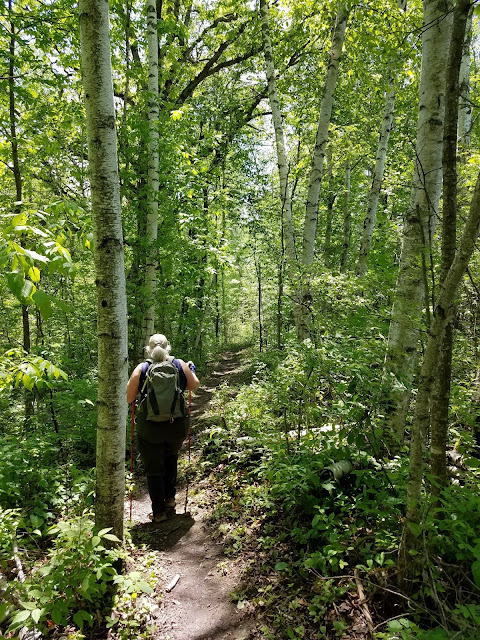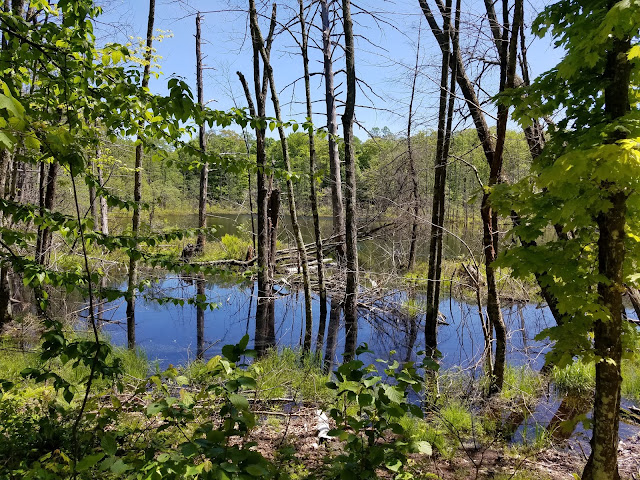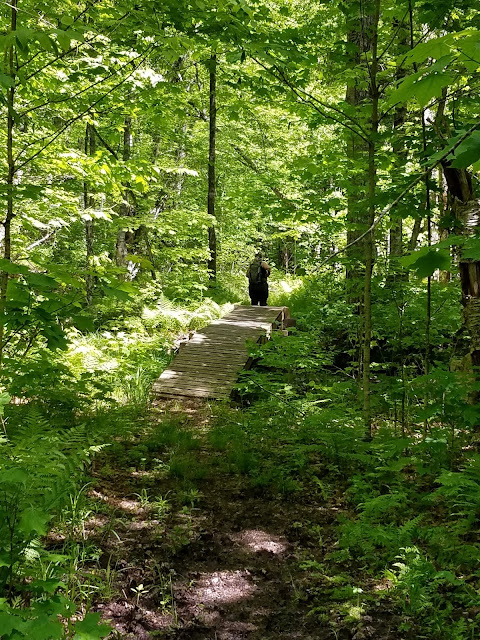Day 70: Chippewa Moraine Segment (Part 2), Harwood Lakes Segment (Part 1), Chippewa County
Day 70: Monday, May 31st, 2021
Total Miles covered for the day: 4.0
Location 1: The Harwood Lakes Segment, along 167th street.
0.2 miles of trail covered
When we started out today we had no intention of hiking the Harwood Lakes Segment. In fact, until we got home, and even until twelve days later, we didn't realize we had, in fact, hiked a small portion of the Harwood Lakes Segment. We were simply looking at the map, driving to the parking area where there was a trail sign that said "Ice Age Trail", marking what we thought was the start of the Harwood Lakes Segment, and hiked the opposite direction.
What we didn't realize was that The Harwood Lakes segment actually runs for a short distance along 167th Street until it meets up with the Chippewa Moraine Segment.
This certainly didn't add much distance to our hike today, but I can say that there was more scenery in those 0.2 miles of roadway that many other connecting routes have in their entire multi-mile repertoire.
Before we knew it (literally) we were on the Chippewa Moraine segment, as intended.
Location 2: Eastern end of the Chippewa Moraine Segment, between 144th Street to the west and 167th Street to the east.
3.8 miles of trail covered
As I mentioned above, I don't really know what time we started hiking the Chippewa Moraine segment today. Since we started at the Parking area on 167th Street at 11:45 am, I'm sure 12:00 noon is close enough. And the temperature was probably still 64 degrees.
The parking area, I should note, is on the east end of Plummer Lake, and features a boat launch and a horseshoe drive-through that I don't recommend for most vehicles. In fact, if you're not driving a truck I recommend against testing the drive-through. There are rocks that will tear out your undercarriage and a pond in the roadway, the depths of which have never been charted. We actually didn't park right there because there were four or five other cars there, making the most of their Memorial Day. We ended up parking on the roadside up by the Trail Sign, which worked out just fine.
But back to the hike.
When we left 167th street, the trail took a brief stroll through a charming corner of woods between Plummer Lake and 260th Avenue, otherwise affectionately known as Rattlesnake Hill Road. For those who think that Wisconsin doesn't have rattlesnakes, please think again. Though neither the timber rattlesnake nor the eastern massasauga can be considered common in Chippewa County, it is not so far outside the native range of these two snakes that it would be impossible to see one. And there is no question this road got its name from somewhere.
This took literally only a few minutes, but when we got to the road we were able to enjoy watching the landowner on the corner working with their horses for a bit.
Then we walked up a fairly steep bit of road that gained us more than 50 feet in elevation before the trail cut north into the woods. Then the woods gave way almost immediately to wide open fields, where the trail was discernable, but only just.
A tenth of a mile later and we were at the large parking area that sits on 260th Ave., but we just kept going through the gate and up onto the top of an ice-walled lake plain where the narrow single-track, which was covered in horsey hoofprints, ran between a close gauntlet of prickly ash trees.
And no, we have not become so good at spotting glacial features that I recognized this fairly open field as an ice-walled lake plain. I knew this because there was an old ratty sign that told me so. At the very apex of the hill was a bench, with a somewhat obstructed view of faraway Dumke Lake. We sat there for a while, because there were no flies, the weather was sunny and warm, and it was Memorial Day, after all, so we used some of our holiday time for relaxing.
This section of trail, by the way, was beautifully marked, and even included orange spray paint on the ground that literally marked almost all of the stubby little tree stumps that stuck up, or roots that were a little too high. We briefly discussed what those marks were for, and we finally concluded, accurately enough we later discovered, that they were put there so that someone else could come through later with appropriate tools and remove them. They served the double-purpose, however, to make hikers aware of them so as not to trip.
 |
Fox and Cubs
|
I've said it before, but it bears repeating. The local chapter of trail volunteers for Chippewa County are the best we have met anywhere, and they work very hard to make the trails as inviting and manageable as possible. That's why we knew those marks were put there as a part of ongoing maintenance, and we confirmed it when we talked to them 12 days later.
They also do a phenomenal job of putting up trail signs, though to be honest I could use a few more plain-old yellow blazes in the woods, too.
I was walking along the trail one day, and I happened to see a frog sitting in a crabapple tree.
"Hello, Mr. Frog! How are you doing today?"
The frog said nothing.
"Are you enjoying the warm weather?" I asked.
The frog said nothing.
"How long have you been sitting here in this crabapple tree?" I asked.
The frog said nothing.
"Well," I said, "I want to thank you for sitting here and making today just a little bit nicer for us."
To my surprise, the frog answered, "You're welcome."
Astonished, I said to the frog, "I didn't realize you could talk! I am curious, though, when I was asking you those questions before, why didn't you answer me?"
"Because," said the frog, "When you were asking me how I was doing, if I liked the weather, and how long I had been sitting here, you were speaking to me as though I was a lesser creature who couldn't possibly understand you."
"And why did you finally answer me the last time?" I asked, puzzled.
"Because when you spoke to me the last time, you were accepting me for exactly what I was, and thanking me for being an important part of this world. It was only when you started treating me as an equal that I also started treating you as an equal."
Once we crossed 160th street the trail ran uphill for a bit, then across a grassy and mucky hilltop before turning into a much nicer single-track through the woods. This all occurred in a span of about a quarter mile, and one of the things we noticed was all the dragonflies that were out.
And lest anyone ever get the mistaken impression that dragonflies are just cute little things that buzz around and don't do much, let me tell you that they are absolutely the winged piranhas of the insect world. Though their primary diet is mosquitoes and midges (I knew I liked these things for a reason), they will also eat almost anything else that is within their weight class or less, including other dragonflies. An adult will eat it's own body weight in other insects every day.
And I got the distinct pleasure of watching one capture a horsefly and make a ridiculously short meal of it. I'm sure if I was watching this at a macro level the imagery would have been horrifying, but on the 'You go, dragonfly!' scale, it was kinda cool.
About the time we reached the point where the trail bumps up against Horseshoe Lake, we saw this sign.This is what made us realize that for the last six tenths of a mile or so, we were walking on brand new trail that had been so well constructed we could hardly tell it was new. This also explained the orange-painted tiny stumps, because the fact that they were there at all was completely inconsistent with how well this group of volunteers maintain their trails.
I have it on good authority that the orange-painted stubs were removed about a week later.
I didn't walk down to see the bridge that was no longer usable, but I wish I had. Horseshoe lake was a pretty spot.
The next two tenths of a mile were a very pretty walk along Horseshoe lake, and we paused briefly to sit on a log and enjoy it.
While we sat, we were passed by two young men out for a 'quick hike', who asked us if we knew what lake this was, because they were hiking without maps, and without any particular means of knowing where they were. Strangely, I happened to know it was horseshoe lake because of the sign, and they said that they had started at the Interpretive Center and were doing an out-and-back hike and weren't sure how far they had come. We told them they had come somewhere just short of five miles, and made sure they had water to drink. They assured us that they were fine (it was clear they didn't have enough liquid, but it's hard to be pushy in that situation), and then we saw them again as they passed us on the way back. Young and in a hurry, it seemed like they wanted to hurry up and get the hiking done before they got onto their next adventure. I'm thinking they'll learn to slow down a little in the next 30 years or so.
The trail continued as a well-worn dirt single-track under a canopy of mostly oak and maple. What we really enjoyed was all the wonderful birdsong. These woods are absolutely full of birds, and they are happy to let you know about it.
As the trail turned north, we encountered more of the same, crossing between two lakes on a steep descent. Right at the saddle, where we started hiking back up the other side, I could see an informal campground on the west side of the trail that seemed like a right fine place to camp, if you're looking for one.
The next zig-zag went to the south again, so as to walk around the southern end of Dam Lake. The trail here is unrelentingly pretty, and fairly easy to walk. So much so that I don't really have anything to add except that it was more of the same beautiful trail.
At Knickerbocker Lake we finally encountered another bench where we could sit a while and enjoy the weather. There were steps leading down to the water's edge, and it was only when I walked all the way down to the lake that I noticed the small bit of civilization across the lake in the form of a lake home. I didn't mind - the lake was big enough to share.
As I sit here now and think back on the last nine tenths of a mile I have almost no distinct memory of the trail, and almost no notes from the hike. I know we passed two more ponds, I know I took a few more pictures, and I know that the hiking was extremely pleasant. I'll let these three photos speak for themselves.
 |
| Prickle Tree Clubmoss |
When we reached our car that was waiting for us at 144th Street it was 4:04 pm, and the temperature had climbed to a surprisingly warm 73 degrees. Thank goodness we were in the shade most of the time and there was a decent breeze.
Looking towards our car that was pulled over alongside the road near the trail sign, we noticed some paper stuck beneath our windshield wiper.
"Are you kidding me?" I said, not at all sure who would leave us a nasty-gram for parking here, or worse, give us a ticket.
Instead, we found a note from our recently acquainted friends, the 'Pointer Sisters', whom we had met the day before up on the Tuscobia Segment.
11:11 am - Hello from the 3 gals from Stevens Point, now known as the "Pointer Sisters". Headed towards 267 😀
(meaning 267th Ave at the far end of the segment).
Oh, how delightful it would have been to have seen these three ladies again, but alas they were hiking the same direction we were, and they had started where we ended. We double-checked the time. "11:11?!?" We only missed them by five minutes. Somehow, they had remembered and recognized our van parked there, 45 miles away from where we had seen them last and were kind enough to leave us a note.
Liked your blog!
When we met them we asked to take their photo for our blog and gave them the name of it. Apparently they had gone out looking for it that evening, but sometimes it takes me a week or two to get around to completing the posts for any given hike. I sincerely hope the Pointer Sisters came back and found their blog photos.
Running Total: 483.6 miles of trail covered; 40.2 miles ‘extra’ hiking/biking. End of Day 70.
.
.
.
.






















































